Day 1 of a four day Autumn Tour in Norfolk today. The weather was a bit too good in some ways – mostly bright, sunny and unseasonably warm. Not ideal for migrants dropping in, but lovely weather to be out birding.
Our first stop was Wells Woods. As we got out of the minibus, we could hear Pink-footed Geese calling and looked up to see a large skein flying in over the car park. These birds had probably just come off the roost and were heading in to the fields to feed. We would be accompanied by the sound of Pink-footed Geese all morning – lots of birds are here for the winter already and over the coming days we would see more arriving all the time.
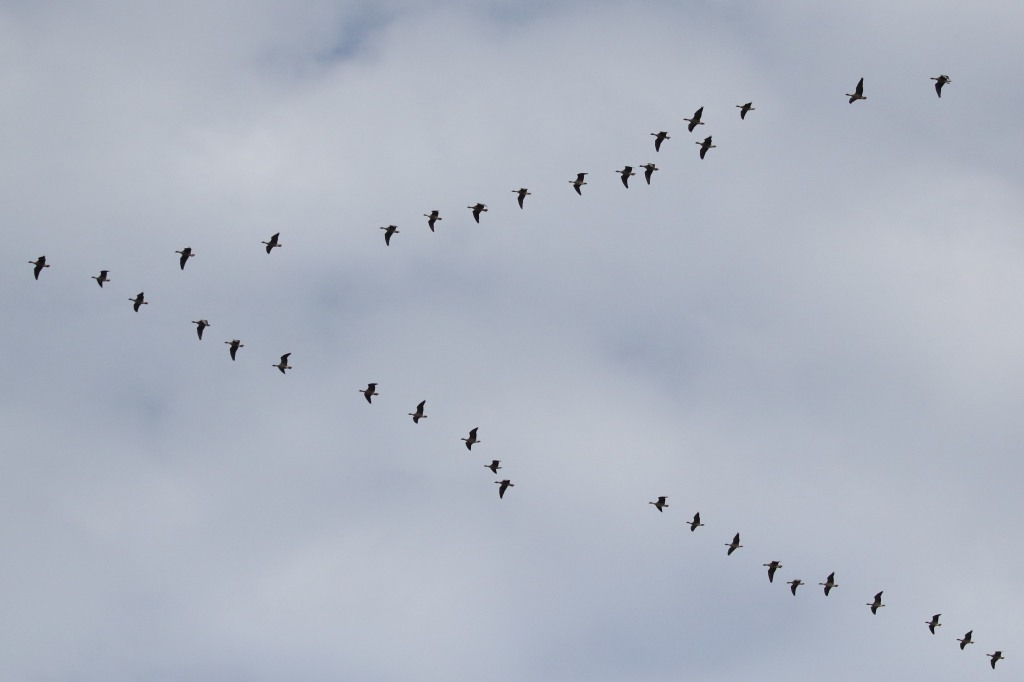
As we made our way in towards the trees, we stopped to scan the boating lake. There were a few Little Grebe and Coot along the edge of the reeds on the far side. A Tufted Duck appeared from out of view round the corner right at the back.
We made our way towards the small path through the birches, but as we got there we could see birds moving in the trees through by the main track so we went round that side instead. Here we found a nice mixed flock. There were Blue, Great and Coat Tits, but no Long-tailed Tits – the latter seem to have had a poor year and there are not the numbers around there normally are. With them, we could see a couple of Chiffchaffs, two Goldcrests chasing each other round the tops, and a Treecreeper which appeared on a bough obligingly above our heads.
The tit flock moved across the path and seemed to disappear off through the trees towards the boating lake. As we turned to move on, a Jay appeared in the top of one of the birches by the path and perched preening in the morning sunshine.

There were more birds flying back and forth across the path further up. A male Blackcap came up into the top of a small hawthorn and two female Bullfinches flew in to the same bush too. We did find a Long-tailed Tit briefly at the back before it disappeared into the caravan park. A Sparrowhawk circled over the pines and the first of several flocks of Lapwings came over high flying west. Birds on the move, coming in from the continent for the winter. More skeins of Pinkfeet came in calling too.
We cut back in to the trees, round the edge of the Dell. Another Chiffchaff was flitting around low down by the path, but otherwise the birches were quiet, so we looped back round and continued on down the main path. We could see that most of the Pinkfeet were dropping down onto Quarles Marsh, so we cut in through the bushes to have a closer look through the gap in the hedge. Two more Blackcaps in were in the hawthorns, fuelling up on berries before the journey south.
Most of the Pinkfeet had dropped down behind the lines of reeds, but there were a couple of small groups on the grass in front of us, which we got in the scopes. We could see their delicate and mostly dark bills, with a small but variable bank of pink around.

One or two Curlew were feeding in the grass near them. Looking inland, we picked up a couple of large flocks of Starlings flying west inland, more birds arriving from the continent for the winter and another theme which would continue through the whole trip.
We carried on round through the bushes, but it was quiet here today, no thrushes fresh in and no more Sylvia warblers in the brambles either. So we made our way back out onto the main path, and continued west. Several Common Buzzards were calling noisily from the pines, and one appeared in the top of a tree by the path briefly.
Diverting in and round the Drinking Pool, we found another flock of tits, coming down to the bushes in the bottom to bathe. We had a better view of a Goldcrest here, when it came up from the pool rather damp and spent some time perched preening above. A Treecreeper was creeping around low down in the grass too. There was another Chiffchaff with them, but no sign of any Yellow-browed Warblers, which we were hoping we might find in here today.
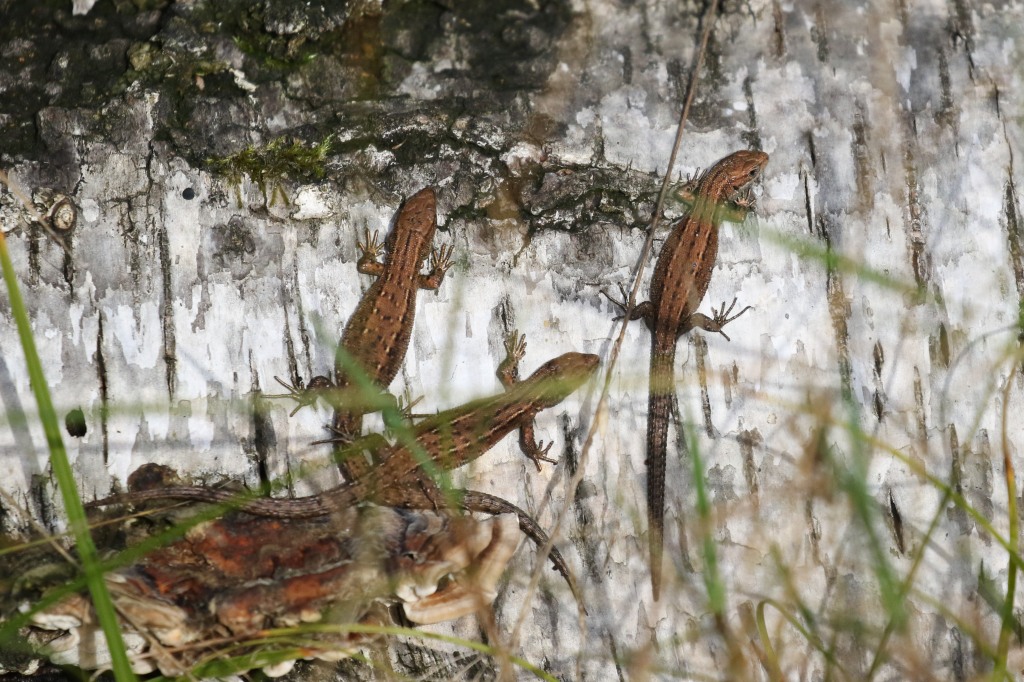
We carried on a bit further west. We stopped to look at a Common Darter dragonfly basking on a white birch log by the path and noticed four small Common Lizards on the same log too. A Willow Emerald damselfly landed on an oak twig just above them.
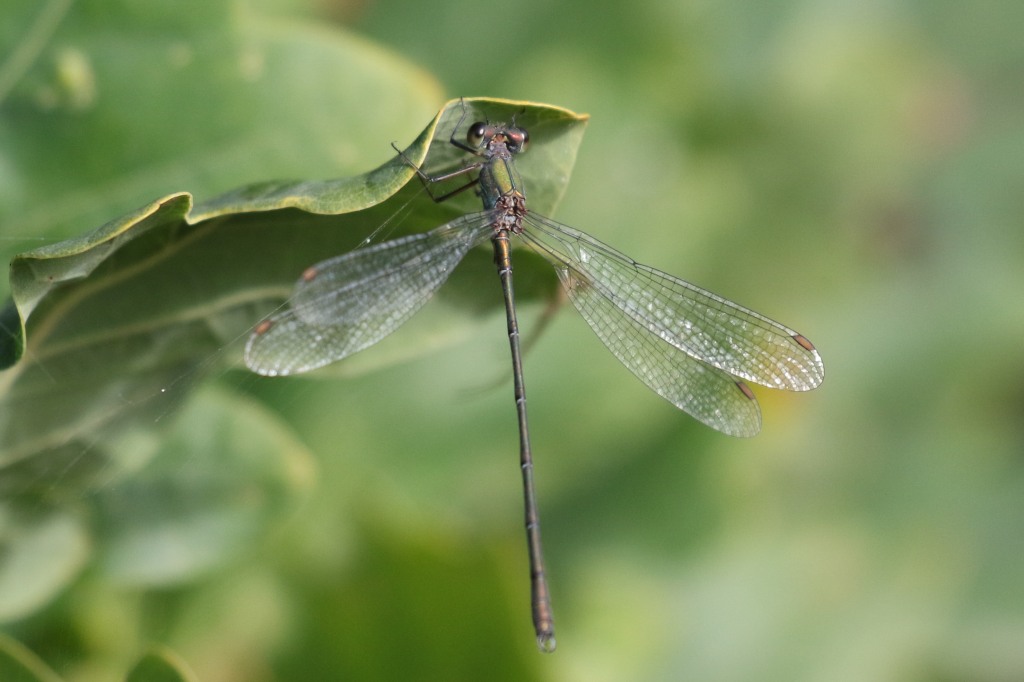
Another couple of locals stopped briefly to look, then walked on past us. We saw them look up into the trees by the path just ahead of us and heard a Yellow-browed Warbler calling as they waved to us. It was hard to see at first, flitting around deep in the bushes on the south side of the path, but we eventually all got a look at it as it came out into a hawthorn more in the open. Smaller and brighter than a Chiffchaff, with a much more prominent pale supercilium and pale wing bars.

It has been a poor year for Yellow-browed Warblers and this may be the first one in Wells this year, and is the first we have seen in Norfolk in 2021. A visitor from Siberia and historically a rarity in UK, in recent decades it has become much more common as the population has expanded west of the Urals. It is now a regular and expected sight in autumn, but for some reason they are late this year and in much smaller numbers so far.
Suddenly the Yellow-browed Warbler started calling repeatedly, and then flew back behind the bushes, where we lost sight of it. We stopped for a while to see if it would start calling again, but it had gone quiet.
There were a few butterflies active now, enjoying the sunshine, Red Admirals and Comma fluttering around the trees. A couple of Common Buzzards circled up and as we walked back, a Red Kite hung in the air over the path ahead of us.
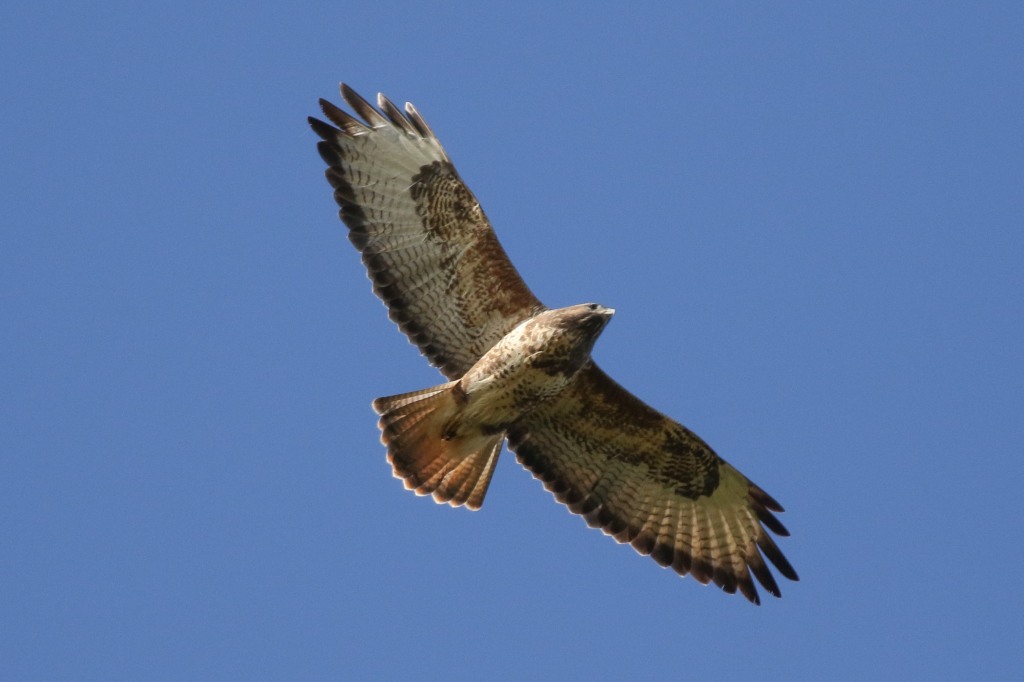
We cut back in to the trees on the west side of the Dell. We ducked in through the dense holm oaks and as we got out of the trees into the open area on the north-west corner of the Dell, we could see a flock of Long-tailed Tits in birches ahead of us. We stopped to look, and a small bird flicked across and landed in a tree at the back. As it flew, we had a flash of black tail and white tail sides, and when it landed, cocking its tail, we realised it was a Red-breasted Flycatcher.
We had a very brief view of it perched in the open but then it flicked up into the branches before everyone could get onto it. We scanned the tree and eventually saw it move again, but it was in the thickest part now, mostly hidden by leaves. Then it moved again and disappeared. We walked round the tree and it had obviously slipped out the back. The tit flock had moved on, so we walked round trying to relocate it. We eventually found the Long-tailed Tits again but there seemed to be nothing with them now.
It was lunch time, so we had to give up and head back to the car park. We put the news out and hoped that someone else could relocate the flycatcher later. We had planned to spend the afternoon at Titchwell, but could always drop back in here later if need be. When we got to Titchwell, the car park was full. Fortunately a couple of people we knew were just leaving and we were able to take their parking place.
As we ate lunch in the picnic area in the sunshine, we could hear one or two Siskins calling somewhere over the trees. After lunch, we headed out to explore the reserve and as we got onto the main path, two Siskins flew out of the alders ahead of us.
Bearded Tit was on the request list, but as we got out of the trees we feared it might be a bit windy. We couldn’t hear any pinging as we walked past the reedbed. The Reedbed Pool was empty today, but a Marsh Harrier was hanging in the air over the bank at the back.
We stopped on the bank just before Island Hide and looked out across the Freshmarsh. We were just scanning the islands when we heard Bearded Tits calling in front of us and looked down to see movement in the reeds between us and the hide. Despite the wind swirling the reeds, we could see a pair of Bearded Tits feeding in the tops, the male with its powder blue-grey head and black drooping moustache.
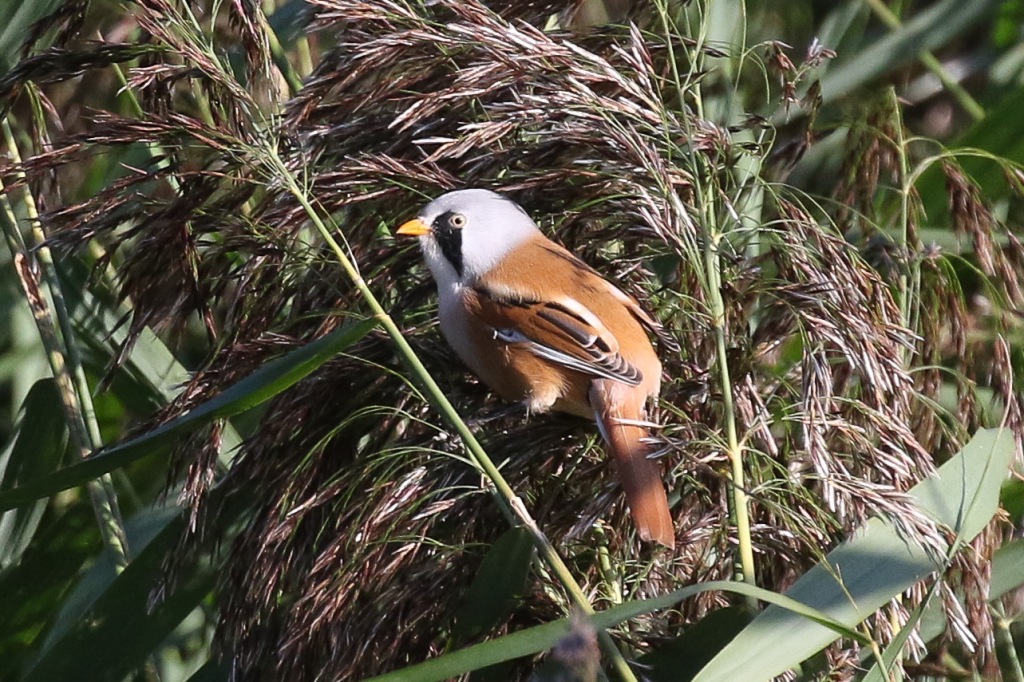
The Bearded Tits kept dropping down out of view and climbing back up, gradually working their way closer towards us. We had a great view now, before suddenly they flew out calling, three of them, across the water and disappeared into the reeds further back.
We carried on a bit further and stopped again up on the main path by the new bund, from where we had a good view of the whole Freshmarsh. The new bank was covered in Golden Plovers, chattering noisily, and we admired their golden spangling shining in the afternoon sunshine. We scanned through carefully but couldn’t find anything in with them today. There were quite a few Lapwings too, and we turned the scopes onto one of those to get a close up view of the wonderful metallic purple and bronze highlights of its green upperparts. Smart birds, some of these waders!

Ruff are always a feature of autumn here and although numbers are dropping now, there were still quite a few here. One adult was working the edge of the new bund right below us. Avocet numbers have dropped too, but we counted at least four still here today.
It has been a good year for Little Stints, and we knew there was still one here somewhere. Scanning the pools, we found it bathing in front of the island between us and Parrinder Hide. It then flew to the new bund and started to pick its way along the edge towards us. We could see how small the Little Stint was, with a short black bill and whiter face and breast than the Dunlin. Though not a particularly strongly marked bird, we could see its white mantle ‘tramlines’ now too. We were hoping it would come right down to the front, but as it got closer the Ruff chased after it and it flew back again.
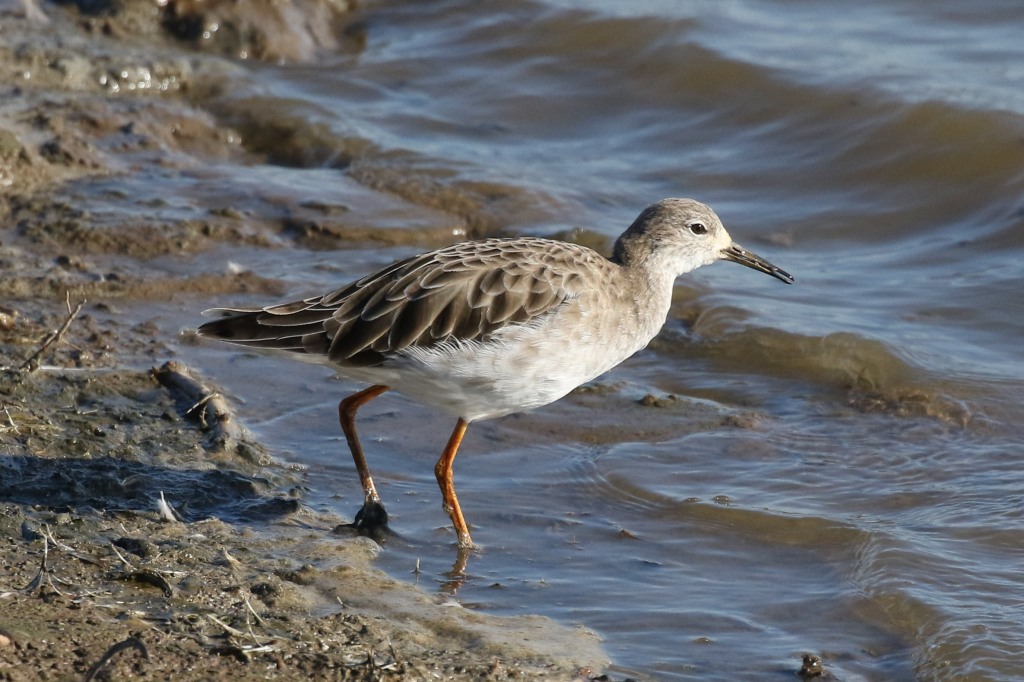
There are good numbers of duck on here now, particularly Teal. Several were asleep on the bank in front of us and we could see one of two of the drakes are starting to moult out of their drab eclipse plumage, starting to get the distinctive drake teal head pattern coming through. Looking over towards the reedbed, a large white shape came up out of the reeds. A Great White Egret, we watched as it flew up with ponderous, heavy wingbeats, before dropping back down again further back.
There were not many gulls on the Freshmarsh at the moment, but one large gull still stood out. We turned the scopes on it and could see it was a young Caspian Gull, a 1st winter. It had a noticeably white head for a 1st calendar year gull, with a snouty face and parallel-sided bill starting to pale at the base. It’s tertials were dark with a distinct white tip and as it preened, we could see it had rather solidly dark inner greater coverts.
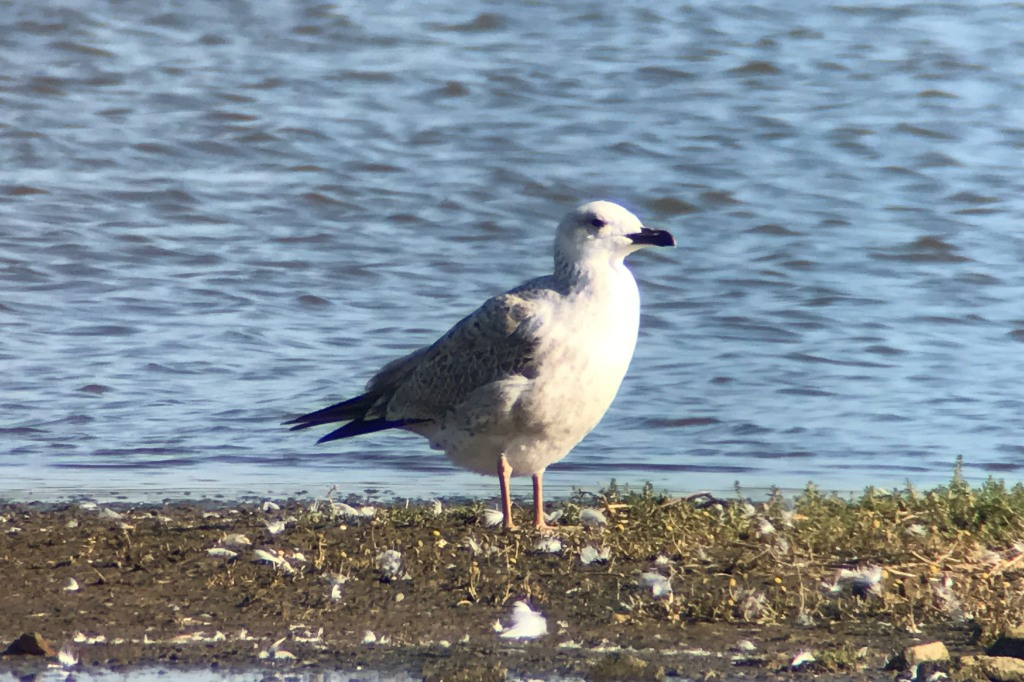
We decided to carry on out to the beach. There was nothing much on Volunteer Marsh as we passed – a few Redshank, Curlew and a single Grey Plover scattered down the channel at the far end. There were a few waders on Tidal Pool, more Redshank and Curlew and one or two Black-tailed Godwits. A single Bar-tailed Godwit was roosting on the spit with two Grey Plover, so we got it in the scope. Unfortunately it took off before everyone could get a closer look and flew off past us. We figured we could find more out on the beach.

The tide was out, but we stopped to scan the sea from the top of the beach first, where we had the benefit of a bit more elevation. There were a few birds out on the water, several Great Crested Grebes, one or two Red-throated Divers and some Common Scoters, but they were all rather distant and tricky to see. A Gannet flew past offshore.
There were lots of gulls scattered feeding on the sand further west, towards Thornham Point. When two large gulls flew past over the bottom of the beach, one stood out with its white head and dark shawl, another 1st winter Caspian Gull with a young Herring Gull for comparison. It was a really good day for the former species, as shortly afterwards yet another 1st winter Caspian Gull flew in over the sea. Two Mediterranean Gulls flew the other way, heading east over the shoreline, a white-winged adult followed by a 1st winter.
There were lots of waders down on the mussel beds, so we walked down over the beach for a closer look. The rocks were covered with Knot again today, and good numbers of Black-tailed Godwits. A Bar-tailed Godwit was feeding on the sand down by the water’s edge beyond and there were a few tiny Sanderling away to the west. A Turnstone picking around the mussels was another addition to the day’s list.
We decided to swing round for a quick look at Patsy’s Reedbed on the way back. As we passed the reedbed on the main path, we could see a large white shape on the new pool in the reeds, a Great White Egret. We could now see its long dagger-like yellow bill. Patsy’s held a few ducks and Little Grebes, but three Pintail were a new bird for the trip. Still in eclipse plumage, they were easily overlooked, but their distinctive shape gave them away, and we could still see their rather pointed tails as they upended in the shallow water.
Then it was time to head back to the minibus. It had been a good first day, but we had another three busy days planned ahead of us.
















